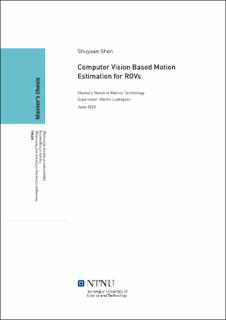| dc.description.abstract | This project thesis presents a real-time visual simultaneous localization and mapping (SLAM) based motion estimation system of remotely operated vehicle (ROV) using a stereo camera. The main purpose is to increase local navigation and situation awareness of the ROV, and increase the ROV autonomy level.
A stereo camera that records sea floor images is equipped on the ROV. The geometric models used in this thesis are pin-hole camera model. The image pairs from the stereo camera are input data to estimate ROV motion based on computer vision techniques. The images are enhanced by contrast limited adaptive histogram equalization (CLAHE) algorithm to improve image contrast.
Map is the core of the SLAM problem. Map points and camera positions, which are called poses in computer vision, are stored in the map. Map points are points that their positions in world coordinate are known. The measurable pieces of data in the image is detected as feature. Oriented Features from Accelerated Segment Test and Rotated Binary Robust Independent Elementary Features (ORB) method is used for feature detector and descriptor. The features from left camera image in current processing frame are matched with map points. Distance filter and Random Sample Consensus (RANSAC) are two steps to remove mismatches.
Camera poses are estimated by Efficient Perspective-n-Point (EPnP) method. The results are optimized using graph based bundle adjustment. The current frame is set as a keyframe if the number of matched features is not large. Features in left and right camera images are matched to calculate new map points. The new keyframe and map points are added in the map for further use. A large bundle adjustment including several nearest keyframes camera poses and new map points is implemented to generate optimized trajectory and map.
A TCP client is included in the system. It establishes connection with TCP server in the ROV control system and receives initial ROV position. The client also reads estimated position results, converts local camera poses to local ROV position and transmits global ROV position to the control system.
The SLAM system is tested in three scenarios based on two different image sets. The results shows that the system is able to estimate ROV motion. But large errors occurs in orientation. The calculation time of one frame is 0.2 seconds on average, meaning the system can process frames at the frequency of 5 Hz.
In order to improve the performance of the system. Other better image enhancement methods should be studied and tested. Besides, loop closure should be considered to add in the system to reduce accumulated drift. | |
